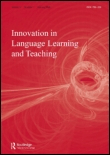
Innovation in Language Learning and Teaching
Scope & Guideline
Pioneering New Horizons in Language Learning and Teaching.
Introduction
Aims and Scopes
- Innovative Pedagogical Approaches:
The journal emphasizes new and creative teaching methodologies that enhance language acquisition, including the use of technology, gamification, and collaborative learning practices. - Research on Teacher Development:
It focuses on exploring the professional growth of language teachers, their engagement with research, and the impact of teacher autonomy and emotional factors on teaching practices. - Learner-Centric Research:
The journal prioritizes studies that investigate learners' experiences, motivations, and emotional responses in language learning contexts, aiming to improve educational outcomes. - Integration of Technology in Language Learning:
There is a strong emphasis on the role of digital tools and online platforms in language education, exploring how these can facilitate learning and engagement. - Cultural and Contextual Perspectives:
The journal encourages research that considers cultural diversity and context-specific challenges in language education, promoting inclusive and equitable teaching practices. - Interdisciplinary Approaches:
It welcomes contributions that draw from various fields such as psychology, sociology, and technology, to enrich language teaching and learning methodologies.
Trending and Emerging
- Emotional and Psychological Factors in Language Learning:
Recent publications have increasingly focused on the emotional aspects of language learning, including anxiety, motivation, and enjoyment, recognizing their critical role in learner engagement and success. - Digital and Online Learning Environments:
There is a growing trend towards exploring the effectiveness of online and blended learning environments, particularly in the context of post-pandemic education, highlighting the importance of flexibility and accessibility. - Gamification and Game-Based Learning:
The integration of gamified elements into language learning has gained traction, focusing on how game mechanics can enhance motivation and engagement among learners. - Translanguaging and Multilingualism:
Emerging research emphasizes the importance of translanguaging practices and multilingual approaches in language education, advocating for more inclusive pedagogies that reflect diverse linguistic backgrounds. - Collaborative Learning and Peer Feedback:
The trend towards collaborative learning models and peer feedback mechanisms is increasing, as educators seek to foster communication skills and critical thinking through group interactions.
Declining or Waning
- Traditional Classroom Practices:
There is a noticeable decline in research focusing solely on conventional teaching methods without integrating innovative or digital approaches, reflecting a broader shift towards more dynamic educational practices. - Focus on Grammar Instruction:
Studies centered around explicit grammar instruction are becoming less frequent, as the field moves towards communicative competence and holistic language use rather than isolated grammatical accuracy. - Standardized Testing Methods:
Research discussing traditional standardized assessments is waning, as educators and researchers explore more formative and dynamic assessment strategies that reflect real-world language use. - Teacher-Centered Pedagogy:
The previous focus on teacher-led instruction is diminishing, with a growing emphasis on learner autonomy and collaborative learning approaches that empower students in their language learning journey. - Static Learning Materials:
There is a reduced focus on static, one-size-fits-all learning materials, as innovative, adaptable, and context-responsive resources are increasingly favored.
Similar Journals

Journal of Technology and Chinese Language Teaching
Harnessing Technology for Effective Chinese TeachingJournal of Technology and Chinese Language Teaching, published by JOURNAL TECHNOLOGY & CHINESE LANGUAGE TEACHING, serves as an influential platform for scholars and practitioners in the intersecting fields of technology, language education, and linguistic research. With an ISSN of 1949-260X, this journal strives to disseminate cutting-edge research and innovative practices aimed at enhancing the teaching and learning of Chinese language through technological advancements. Operated from the United States, it currently occupies valuable quartiles within its categories, showcasing its significance—ranking Q4 in Computer Science Applications, Q3 in Education, and Q2 in Linguistics and Language. As it spans from 2019 to 2024, the journal provides a rich repository for international contributions, fostering a collaborative environment for educators, researchers, and students alike. With both Scopus and HIndex metrics reflecting a solid reputation, the Journal of Technology and Chinese Language Teaching is pivotal for those keen on pushing the boundaries of language instruction in the digital age.

Advanced Education
Transforming Education with Interdisciplinary InsightsAdvanced Education is a distinguished open-access journal dedicated to the interdisciplinary study of educational methodologies and innovations, published by the National Technical University of Ukraine - Kyiv Polytechnic Institute, Faculty of Linguistics. Since its inception in 2014, the journal has endeavored to disseminate high-quality research findings and theoretical work that contribute to advancements in educational practices and policy-making. With the increasing need for accessible education resources in our rapidly evolving global landscape, Advanced Education plays a critical role in bridging gaps between linguistic studies and educational technology, providing a platform for scholars, educators, and practitioners to share their insights. The journal aspires to enhance educational quality and effectiveness, making it an indispensable resource for researchers, professionals, and students engaged in the field of education.

Malaysian Journal of ELT Research
Shaping the Future of English Language Teaching TogetherMalaysian Journal of ELT Research is a pioneering platform dedicated to advancing the field of English Language Teaching (ELT) research, published by the Malaysian English Language Teaching Association. With an ISSN of 1511-8002, this journal serves as a vital resource for educators, researchers, and practitioners who are passionate about enhancing English language instruction in Malaysia and beyond. Although specific impact factors are currently not available, the journal's commitment to quality research is evident in its rigorous peer-review process, fostering innovative studies that address contemporary challenges in ELT. The journal embraces a wide range of topics within English language pedagogy, including but not limited to curriculum development, teaching methodologies, and language assessment. It provides an open-access model, ensuring that valuable research insights are readily accessible to a global audience. With its strategic focus on enriching English language education, the Malaysian Journal of ELT Research stands as an important contributor to scholarly discourse in the realm of language teaching and learning.
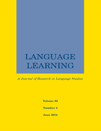
LANGUAGE LEARNING
Innovating research in language acquisition since 1948.LANGUAGE LEARNING is a premier academic journal dedicated to advancing the field of language acquisition and education, published by Wiley. With a foundation dating back to 1948, the journal has carved an esteemed niche in the academic landscape, currently holding a prestigious Q1 rank in both the categories of Education and Linguistics and Language. It proudly occupies the 9th percentile rank in the Arts and Humanities domain and the 10th percentile in Social Sciences, illustrating its influence and reach. The journal publishes high-quality research that explores various dimensions of language learning, from cognitive processes to pedagogical approaches, making it an essential resource for researchers, educators, and students alike. Although Access options are non-open, the journal remains accessible to a wide audience, reinforcing its commitment to disseminating critical insights within the academic community.
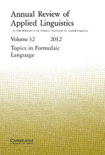
Annual Review of Applied Linguistics
Elevating scholarship in applied linguistics.The Annual Review of Applied Linguistics, published by Cambridge University Press, stands as a premier journal in the realm of linguistics and psychology, with an impressive impact factor identifying its significance: ranking in the Q1 quartile across both fields in 2023. With an ISSN of 0267-1905 and an E-ISSN of 1471-6356, this journal endeavors to provide comprehensive and insightful reviews covering an array of topics within applied linguistics, thus supporting researchers, professionals, and students in advancing their understanding and expertise. Operating from its base in Cambridge, United Kingdom, the journal has maintained a consistent commitment to scholarly excellence since its inception, accelerating discussions on critical issues and emerging research trends from 2005 to 2024. Notably, it holds a prestigious position in Scopus, ranked #26 in Language and Linguistics and #30 in Social Sciences, showcasing its influence and contribution to the scholarship in the field. The Annual Review of Applied Linguistics thus stands as an essential resource for anyone engaged in linguistic research and application.
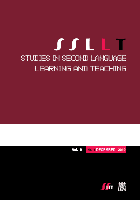
Studies in Second Language Learning and Teaching
Connecting researchers and practitioners in linguistics.Studies in Second Language Learning and Teaching is a premier open-access journal dedicated to advancing research and scholarship in the fields of education, linguistics, and language acquisition. Published by ADAM MICKIEWICZ UNIVERSITY, KALISZ, this journal has consistently achieved high acclaim, reflected in its impressive Q1 rankings in both Education and Linguistics and Language categories for 2023. With a robust focus on innovative methods, effective pedagogical strategies, and interdisciplinary approaches, Studies in Second Language Learning and Teaching aims to facilitate dialogue among researchers, educators, and practitioners, fostering a deeper understanding of language learning and teaching in diverse contexts. Since its transition to open access in 2011, the journal has expanded its reach, providing valuable resources and research findings to a global audience. With an exceptional Scopus ranking placing it in the top percentiles across multiple categories, this journal stands as a crucial platform for the dissemination of ground-breaking research in second language education.

Language Learning in Higher Education
Elevating language learning practices in academia.Language Learning in Higher Education is a prominent academic journal published by DE GRUYTER MOUTON, dedicated to exploring the intricate dynamics of language acquisition and pedagogical practices within the higher education context. With a robust ISSN: 2191-611X and E-ISSN: 2191-6128, this journal provides a platform for innovative research that addresses contemporary challenges and methodologies in language education. The journal enjoys a favorable reputation in the academic community, as evidenced by its ranks in the Scopus database, where it holds a position in the 67th percentile for Language and Linguistics and is classified in the Q3 and Q2 quartiles across relevant education and linguistics categories. Since its convergence in 2017, Language Learning in Higher Education aims to enrich scholarly discourse by publishing high-quality articles that foster insights into effective language learning strategies, thus serving as an essential resource for researchers, educators, and students committed to enhancing language education. The journal's editorial team is devoted to advancing the field through rigorous peer-review processes and welcomes contributions that push the boundaries of language learning research.
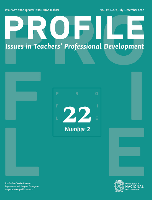
Profile-Issues in Teachers Professional Development
Navigating Change: Essential Research for Educators' GrowthProfile - Issues in Teachers Professional Development is a distinguished open access journal published by the Universidad Nacional de Colombia, Facultad Ciencias Humanas, aimed at fostering research and discourse surrounding critical issues in educators' ongoing professional development. Since its inception in 2005, the journal has established itself as a significant resource within the fields of Education and Linguistics and Language, reflecting its relevance through its category quartiles, being positioned in Q3 in Education and an impressive Q1 in Linguistics and Language for 2023. The journal boasts a commendable Scopus ranking, reflecting its impact and commitment to advancing scholarly discussion, with rankings of #236 out of 1167 in Linguistics and Language, and #818 out of 1543 in Education. With a converged timeline from 2018 to 2024, it serves as a vital platform for educators, researchers, and students alike, encouraging the dissemination of innovative practices and insights essential for the evolution of teacher training and professional growth in a rapidly changing educational landscape.
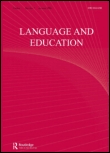
Language and Education
Shaping the Future of Language Acquisition and PedagogyLanguage and Education is a leading academic journal published by Routledge Journals, Taylor & Francis Ltd, specializing in the intersection of language studies and educational practices. With an impressive Q1 ranking in both Education and Linguistics and Language categories for 2023, it stands out as a crucial resource for researchers, educators, and industry professionals. Covering a wide array of topics pertinent to language acquisition, pedagogical methodologies, and culturally responsive education, this journal supports rigorous scholarship in the field. While not currently offering open access options, its contributions are vital for advancing knowledge and fostering innovation across disciplines. The journal's long-term commitment to excellence is evidenced by its high rankings in Scopus, placing it in the 94th percentile in Language and Linguistics and the 80th percentile in Education. Since its inception in 1987, Language and Education has not only tracked the evolving landscape of language education but has also actively shaped it, making it an indispensable tool for anyone invested in educational research and practice.
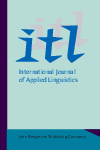
ITL-International Journal of Applied Linguistics
Advancing knowledge in applied linguistics and education.ITL-International Journal of Applied Linguistics, published by JOHN BENJAMINS PUBLISHING CO in Belgium, stands as a leading journal in the field of applied linguistics and education, recognized for its rigorous scholarship and impactful contributions. With an impressive ranking of Q1 in both the Education and Linguistics and Language categories, ITL holds its place among the top journals globally, featuring in the Scopus rankings with a notable 91st percentile in both Arts and Humanities as well as Social Sciences. The journal aims to disseminate innovative research exploring the intersection of linguistics, language acquisition, and pedagogical practices, fostering a rich academic dialogue among researchers, educators, and practitioners. Though not currently an open access journal, ITL remains accessible to a broad readership, with an emphasis on high-quality, peer-reviewed articles that inform and inspire advancements in applied linguistics. The journal's commitment to academic excellence and relevance makes it an essential resource for those seeking to understand and contribute to the dynamic landscape of language studies.